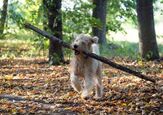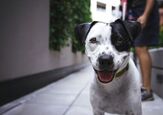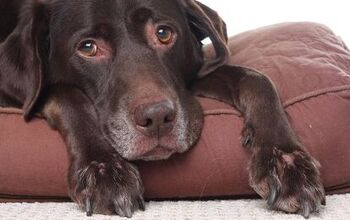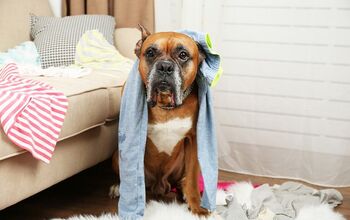Creative Ways to Adapt Your Home for Your Senior Dog

Our dogs are family, and watching them transition into their golden years is truly a privilege, but it’s also undeniably bittersweet. We want nothing more than to ensure their remaining time is filled with comfort, joy, and peace. However, this new chapter of their lives introduces potential challenges, such as stiffness, less table footing, and perhaps a bit of confusion. This is where we step in.
We have the power to make their home environment not just safe, but a true sanctuary for them as they navigate the changes that come with aging. You don’t need a full renovation; just a strategy focusing on smaller, targeted changes that address key concerns, like mobility, failing vision, temperature sensitivity, and overall safety.
This guide will help you identify creative, practical, and highly effective ways you can adapt your home to your pup’s changing needs.
Mobility and Joint Comfort
For many senior dogs, the first noticeable sign of aging is a change in how they move. Arthritis, joint stiffness, and muscle weakness can all make moving through their once familiar and comfortable home into a painful obstacle course. Minor changes throughout your home can help to restore your dog’s confidence and prevent strain and injury.
Traction Solutions
Hardwood, tile, and laminate floors are comfortable for us, but they can be terrifying for a dog with achy, painful joints. The slippery surfaces force them to splay their legs, putting extreme stress on their hips and knees just to stand up. A single slip on any surface could cause a serious injury.
Consider placing floor runners and area rugs in strategic places throughout your home. You don’t need to carpet the entire house; just focus on creating a “traction highway” in high-traffic areas. For example, place non-slip rugs along the path from their bed to the front door, from the living room to their food bowls, and around any area where they frequently hang out or stand up. For my senior girl, Daviana, this included creating a pathway into my home office where she would accompany me during my workday.
Even a basic plush rug can be a hazard if it slides out from under them. If your favourite rug isn’t non-slip, consider using a rubber or specialized anti-slip rug pad underneath to give it that extra traction boost.
Are new rugs throughout your house out of your budget? Rugs can be expensive! A budget-friendly solution is to place yoga mats in the key areas where traction is needed.
Finally, take a moment to consider your dog’s paws and paw pads. Keep the fur between the paw pads neatly trimmed if your pup lets you handle them. Long hair here reduces their natural grip. You can also use paw wax or dog-specific traction socks with rubber grips to help them navigate slick floors more effectively.
Ramps and Steps
Gone are the days when your dog effortlessly dove onto the couch or flew up the steps with ease. Why? Jumping, especially the sudden impact of jumping down, can be really hard on stiff joints. Eventually, the pain becomes too much, and your dog must make the difficult decision to give up these once-enjoyable experiences. But that doesn’t have to be the case! You can help your pup navigate the same pathways without the strain.
For accessing furniture or getting in and out of the car, a low-incline pet ramp is generally safer and easier on the joints than pet stairs. There are adjustable and aesthetic options to suit your home, as well as compact, travel-friendly ramps for your car.
If your senior dog is no longer able to navigate a full set of stairs in your house, you need to block their access entirely. This could be done by closing a door to block a portion of your home, if possible, or by using a safety gate directly at the stairs themselves.
If your senior pup must access another floor, a lifting harness may be necessary. This requires physical effort from you and should only be done if the pathway is clear.
Elevated Food and Water Bowls
When it comes to mealtime, consider switching to elevated food and water bowls. This simple change keeps their head at a comfortable level, reducing the need to strain their neck, shoulder, and pack while they eat and drink. You can purchase a raised feeder, or for a more budget-friendly solution, consider placing your dog’s dishes on a cardboard box and cutting a hole to hold the dish securely in place.
Orthopedic Bedding
Your senior dog will spend more time resting during this stage of their life than they have ever before. Their old plush bed is no longer enough. If they sink into the overly soft bed, it can lead to stress on pressure points and uncomfortable sleeping positions, making their already stiff, sore joints even more painful. Instead, they need more targeted support.
A high-quality orthopedic or memory foam bed is the single best investment you can make for your dog’s joint comfort. It contours to their body, evenly distributing weight and relieving pressure points, while still creating a cozy place to rest. This means less pain and better sleep. Look for a bed that is low to the ground or has a low entry point so your dog doesn’t have to step up or over a barrier to get in.
Place several comfortable beds strategically throughout the house in the areas where your pup spends most of their time. This could include near their food dish, beside your favorite chair, or in a quiet corner. This will ensure they are never far from a comfortable resting place, especially when they feel tired, and won’t be tempted to strain themselves by walking long distances to take a much-needed rest.
Vision and Hearing
As our dogs age, it’s not just their bodies that change; their senses do, too. Decreased vision, hearing loss, and even signs of Canine Cognitive Dysfunction (CCD or “doggie dementia”) can cause significant anxiety and disorientation. A familiar home can suddenly feel confusing and scary. By creating consistency and providing creative cues, you can help rebuild their confidence.
Failing Vision
A dog with failing eyesight doesn’t navigate by looking; they navigate their surroundings by memory and scent. Every piece of furniture is a mental landmark. This means maintaining their environment the way they know it is a top priority. Avoid rearranging furniture or making significant changes to your home's layout. Moving a sofa, even a few feet, can remove a crucial reference point, causing them to bump into things, become instantly anxious, and potentially cause injuries.
While you shouldn’t move the main furniture, you must clear any clutter in your home. Items left randomly on the floor, such as shoes, laundry baskets, children’s toys, or exercise equipment, can become dangerous, creating unexpected trip hazards in their established pathways.
Use your dog’s most powerful sense, their sense of smell, to help them find key areas in the home. Place a distinctive rug or mat outside the door they use for potty breaks, or use a specific, pet-safe calming scent (like a lavender sachet) near their bed. The use of smell and texture can act as a “you are here” sign.
Lighting the Path
Nighttime can be particularly stressful for dogs with vision loss, making them hesitant to move and potentially leading to accidents and injuries.
Install plug-in night lights along all the major routes: near their sleeping area, leading toward the door, and around their food and water station(s). Motion-sensor lights work exceptionally well in hallways, ensuring the light only comes on when needed.
If you have to deal with a small step or a subtle transition between rooms, use a strip of bright, contrasting-colored tape (like a neon green or orange) on the edge of the step or ramp. This will help them distinguish the elevation change, especially if their vision is lowered but not completely gone.
Hearing Loss
If your dog seems to be ignoring you suddenly, it’s often not stubbornness; it’s deafness. You need to establish a new “vocabulary” that doesn’t rely on sound. Start introducing clear, open-handed hand signals to replace verbal commands. Even if they can still hear a little, these signals will make it easier to communicate what you’re asking for while also preparing you both for the possibility of complete hearing loss.
Leverage the power of vibration to communicate. A gentle stomp on the floor will create a vibration that can travel through the ground and get their attention without starting them.
Always approach your resting or sleeping senior dog from the front or side so they can see you coming. Before touching them, give a gentle visual cue or a soft tap on the ground to alert them that you are there. Being suddenly grabbed or touched when they can’t hear you approach can be extremely frightening and might lead to a reactive snap.
Environmental and Cognitive Concerns
Beyond movement and the senses, senior dogs face challenges with regulating their internal environment and managing the anxiety that can accompany age-related cognitive changes. With simple adjustments, you can focus on comfort, safety, and maintaining a sense of routine.
Temperature Regulation
A dog’s ability to maintain a comfortable body temperature changes as they get older. They often have reduced muscle mass (less insulation) and conditions like arthritis that make them more sensitive to the cold. Conversely, they can also overheat easily.
To combat the chill, place your dog’s beds and rest areas away from drafty windows, doors, and air conditioning vents. Provide safe, cozy blankets that they can easily snuggle into. For dogs with particularly painful arthritis, a low-heat, pet-safe warming pad (always equipped with an automatic shut-off feature and never placed directly on the skin) can provide comfort and relief. A lightweight dog sweater or coat can make a huge difference, especially for smaller, thin-coated, or very frail seniors during the colder months.
To beat the heat, ensure your dog always has access to a cool, shaded area during the warmer months. Provide cooling mats or tile that they can lie on to dissipate heat safely. Always have a minimum of two fresh water bowls readily available on the main floor of your home to ensure they never run out.
Incontinence and Accidents
Urinary incontinence and reduced mobility can often lead to accidents in the house, even if your dog has been house-trained without incident throughout their life. This is a common part of aging and should be treated with compassion, not frustration. The simplest solution is proactive management. Take your dog out more often than you think they need to go, especially first thing in the morning, after meals, after waking up from a nap, and right before bed.
Ensure the path to their designated outdoor potty spot is short, clear of obstacles, and offers excellent traction.
For nights or when you must leave them alone, use absorbent pee pads or indoor grass patches near your dog’s sleeping area. This offers them a high-comfort, low-effort solution, minimizing their stress and preventing them from having an accident in their bed or on your floor. Use waterproof dog blankets underneath their bedding and strategically place washable, quick-dry rugs to make cleanup simple and reduce odor.
Trip and Fall Prevention
Every home has hidden hazards that a quick, mobile dog can handle, but which become dangerous for a slower, vision-impaired senior. Use safety gates or exercise pens to block off areas that pose a significant fall risk, such as swimming pools, steep stairs, or uneven garage steps.
Tidy and secure all electrical cords that run along the floor using cord covers or furniture clips. A stiff or disoriented dog could easily trip over them otherwise.
For a dog with failing vision or a pup who is unsteady on their feet, bumping into furniture is inevitable. Consider placing childproof corner protectors on the sharp, low edges of coffee tables, hearths, or media cabinets that sit at their head level. Alternatively, you could take a budget-friendly pool noodle and cut it to create a corner protector.
Mental Enrichment
Just like humans, mental exercise is essential for preventing or slowing the effects of Canine Cognitive Dysfunction (CCD). A sharp mind is a happy mind.
Use food puzzles, gentle snuffle mats, or lick mats to engage their brain without straining their body. These activities are calming and satisfying. Hide low-calorie treats around the house in easy-to-reach places (under a mat, behind a couch leg), and encourage them to use their nose. Scent work is a great low-mobility mental workout that taps into their most powerful sense.
Practice very brief sessions of familiar, easy commands (“sit,” “stay,” “paw”). The consistency reinforces memory while also creating a positive interaction that continues to strengthen the bond you share.
Invest in Your Senior Dog’s Comfort
The journey into creating a senior sanctuary is, fundamentally, an act of love. By focusing on the smaller details, from the texture of the floor beneath their paws to the placement of a calming nightlight, you can create a home environment that meets their needs during this chapter of their life. These adaptations are more than just home hacks; they are an investment in your dog’s quality of life. They restore confidence, reduce anxiety, and most importantly, allow your pup to feel safe and secure right where they belong: in your happy home.
Join the PetGuide community. Get the latest pet news and product recommendations by subscribing to our newsletter here.

Britt Kascjak is a proud pet mom, sharing her heart (and her home) with her “pack” which includes her husband John, their 2 dogs – Lucifer and Willow – and their 3 cats – Pippen, Jinx, and Theia. She has been active in the animal rescue community for over 15 years, volunteering, fostering and advocating for organizations across Canada and the US. In her free time, she enjoys traveling around the country camping, hiking, and canoeing with her pets.
More by Britt
























